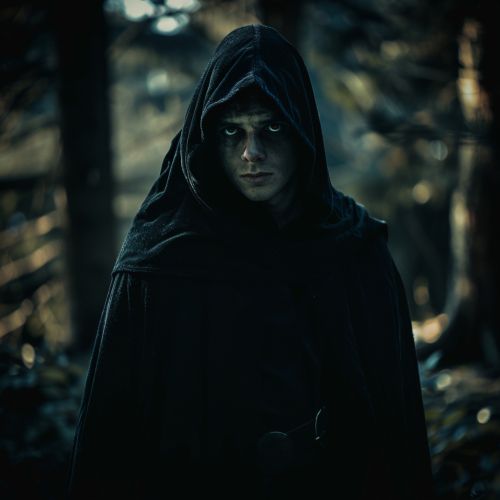Villain: Difference between revisions
No edit summary |
No edit summary |
||
| Line 5: | Line 5: | ||
Villains are often characterized by their malicious intentions, unethical actions, and desire to cause harm or chaos. They are typically in direct conflict with the hero, serving as the primary obstacle the hero must overcome. Villains can take many forms, ranging from humans with malevolent intent to supernatural beings with destructive powers. They may be driven by a variety of motivations, such as revenge, power, control, or simply the desire to cause harm. | Villains are often characterized by their malicious intentions, unethical actions, and desire to cause harm or chaos. They are typically in direct conflict with the hero, serving as the primary obstacle the hero must overcome. Villains can take many forms, ranging from humans with malevolent intent to supernatural beings with destructive powers. They may be driven by a variety of motivations, such as revenge, power, control, or simply the desire to cause harm. | ||
[[Image:Detail-78899.jpg|thumb|center|A person in a dark cloak looking menacingly at the camera.]] | [[Image:Detail-78899.jpg|thumb|center|A person in a dark cloak looking menacingly at the camera.|class=only_on_mobile]] | ||
[[Image:Detail-78900.jpg|thumb|center|A person in a dark cloak looking menacingly at the camera.|class=only_on_desktop]] | |||
== Types of Villains == | == Types of Villains == | ||
Latest revision as of 03:10, 16 May 2024
Definition and Etymology
A villain is a character in a story or piece of literature who opposes the hero or protagonist. The term originates from the Old French word 'villain', which was derived from the Latin 'villanus', meaning 'farmhand'. It was used to denote someone of low social status or ignoble character. Over time, the term evolved to represent a character who embodies evil and immorality.
Characteristics
Villains are often characterized by their malicious intentions, unethical actions, and desire to cause harm or chaos. They are typically in direct conflict with the hero, serving as the primary obstacle the hero must overcome. Villains can take many forms, ranging from humans with malevolent intent to supernatural beings with destructive powers. They may be driven by a variety of motivations, such as revenge, power, control, or simply the desire to cause harm.


Types of Villains
There are various types of villains, each with their own unique characteristics and motivations.
Antagonist
The antagonist is the character who opposes the protagonist or hero of the story. This character is not necessarily evil or immoral, but their goals and actions are in direct conflict with those of the protagonist.
Anti-Hero
An anti-hero is a character who lacks the traditional heroic qualities such as courage, morality, and idealism. Despite this, they are often the protagonist of the story and may even possess a sense of justice or morality, albeit skewed or unconventional.
Supervillain
A supervillain is a character, often in comic books or superhero films, who possesses superhuman abilities or advanced technology and uses them for evil purposes. They are typically the archenemy of a superhero.
Tragic Villain
A tragic villain is a character who is not inherently evil, but becomes a villain due to circumstances beyond their control or tragic events in their past. Their actions are often driven by despair or a desire for revenge.
Villains in Literature
Villains play a crucial role in literature, serving as a foil to the hero and driving the plot forward. They are often complex characters with their own motivations and backstory, providing depth to the narrative and challenging the hero in unique ways.
Shakespearean Villains
Shakespeare is known for creating some of the most memorable villains in literature. Characters such as Iago in Othello, Lady Macbeth in Macbeth, and Richard III in Richard III are renowned for their cunning, deceit, and ambition.
Gothic Literature
Villains in Gothic literature often embody supernatural elements and are characterized by their malevolence and desire to cause harm. Characters such as Count Dracula in Dracula and the monster in Frankenstein are examples of this.
Modern Literature
In modern literature, villains are often more complex and multidimensional. They may not be entirely evil, but rather flawed individuals with their own motivations and backstory. Examples include Lord Voldemort in the Harry Potter series and the White Witch in The Chronicles of Narnia.
Villains in Film and Television
Villains in film and television serve a similar role to those in literature, providing conflict and driving the plot forward. They range from human antagonists with malicious intent to supernatural beings with destructive powers.
Classic Film Villains
Classic film villains such as Darth Vader in Star Wars, Hannibal Lecter in The Silence of the Lambs, and the Wicked Witch of the West in The Wizard of Oz are renowned for their malevolence and memorable performances.
Animated Villains
Animated films often feature villains who serve as a foil to the hero and provide comedic relief. Examples include Scar in The Lion King, Ursula in The Little Mermaid, and Hades in Hercules.
Television Villains
Television series often have recurring villains who provide ongoing conflict for the protagonists. These characters, such as Cersei Lannister in Game of Thrones and Walter White in Breaking Bad, are often complex and multidimensional, providing depth to the narrative.
